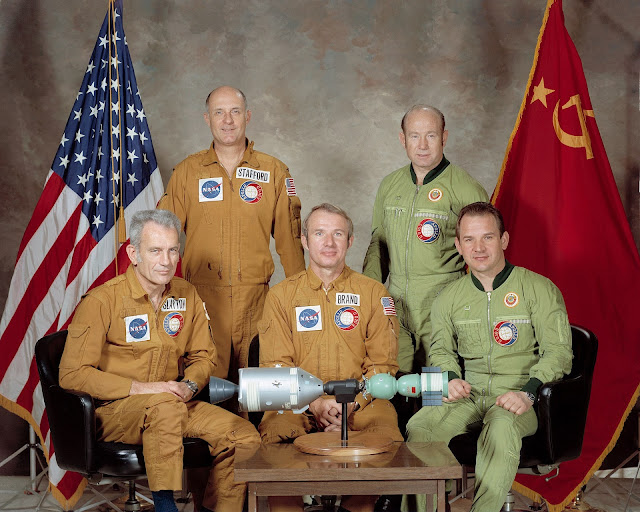On This Date In History
On July 17, 1975, as part of a mission aimed at developing space rescue capability, the U.S. spacecraft Apollo 18 and the Soviet spacecraft Soyuz 19 rendezvous and dock in space. As the hatch was opened between the two vessels, commanders Thomas P. Safford and Aleksei Leonov shook hands and exchanged gifts in celebration of the first such meeting between the two Cold War adversaries in space. Back on Earth, United Nations Secretary General Kurt Waldheim congratulated the two superpowers for the Apollo-Soyuz Test Project and praised their unprecedented spirit of cooperation and peace in planning and executing the mission.
During the 44-hour Apollo-Soyuz embrace, the astronauts and cosmonauts conducted experiments, shared meals, and held a joint news conference. Apollo-Soyuz, which came almost three years after the sixth and last U.S. lunar landing, was the final Apollo program mission conducted by NASA. It was fitting that the Apollo program, which first visited the moon under the banner of “We came in peace for all mankind,” should end on a note of peace and international cooperation.
S75-22410 (March 1975) These five men compose the two prime crews of the first-ever two-nation cooperative space mission, known in the US as the Apollo-Soyuz Test Project (ASTP) and in the Soviet Union as the Soyuz-Apollo Experimental Flight (Russian: Экспериментальный полёт Союз-Аполлон, Eksperimantalniy polyot Soyuz-Apollon). This was a docking mission in Earth orbit scheduled for July 1975. They are astronaut Thomas P. Stafford (standing on left), commander of the American crew; cosmonaut Aleksey A. Leonov (standing on right), commander of the Soviet crew; astronaut Donald K. Slayton (seated on left), docking module pilot of the American crew; astronaut Vance D. Brand (seated center), command module pilot of the American crew; and cosmonaut Valeriy N. Kubasov (seated on right), engineer on the Soviet crew. The crew members wear the same mission patch, but oriented to reflect "Soyuz-Apollo" or "Apollo-Soyuz", as the program was called in their respective countries.
On July 17, 1945, the final “Big Three” meeting between the United States, the Soviet Union and Great Britain takes place towards the end of World War II. The decisions reached at the conference ostensibly settled many of the pressing issues between the three wartime allies, but the meeting was also marked by growing suspicion and tension between the United States and the Soviet Union.
On July 17, 1945, U.S. President Harry S. Truman, Soviet leader Joseph Stalin, and British Prime Minister Winston Churchill met in the Berlin suburb of Potsdam to discuss issues relating to postwar Europe and plans to deal with the ongoing conflict with Japan. By the time the meeting began, U.S. and British suspicions concerning Soviet intentions in Europe were intensifying. Russian armies occupied most of Eastern Europe, including nearly half of Germany, and Stalin showed no inclination to remove his control of the region. Truman, who had only been president since Franklin D. Roosevelt died three months earlier, arrived at the meeting determined to be “tough” with Stalin. He was encouraged in this course of action by news that American scientists had just successfully tested the atomic bomb.
The conference soon bogged down on the issue of postwar Germany. The Soviets wanted a united but disarmed Germany, with each of the Allied powers determining the destiny of the defeated power. Truman and his advisors, fearing the spread of Soviet influence over all Germany, and, by extension, all of western Europe, fought for and achieved an agreement whereby each Allied power (including France) would administer a zone of occupation in Germany. Russian influence, therefore, would be limited to its own eastern zone. The United States also limited the amount of reparations Russia could take from Germany. Discussion of the continuing Soviet occupation of Poland floundered.
When the conference ended on August 2, 1945, matters stood much where they had before the meeting. There would be no further wartime conferences. Four days after the conference concluded, the United States dropped an atomic bomb on Hiroshima in Japan; on August 9, another bomb was dropped on Nagasaki. World War II officially came to an end on August 14, 1945.
British Prime Minister Winston Churchill, American President Harry Truman and Soviet Premier Joseph Stalin at the Potsdam Conference, codenamed 'Terminal', in July 1945.








No comments:
Post a Comment